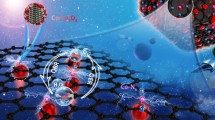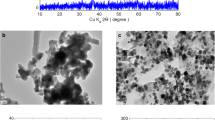Abstract
Efficient and durable bifunctional oxygen electrocatalysts are critical for advanced rechargeable zinc-air (Zn-air) batteries. However, the obstacle to the development of bifunctional electrocatalysts for the oxygen reduction reaction (ORR)/oxygen evolution reaction (OER) lies in the different requirements of the ORR and OER for catalytic materials. Herein, La0.75Sr0.25Mn0.5X0.5O3 (X = Co, Ni, and Fe) perovskite nanoparticles were created by rationally screening targeted ORR/OER components and precisely controlling their electronic structures to achieve bifunctional oxygen electrocatalysis, in which La0.75Sr0.25Mn0.5Fe0.5O3 (LSFMO) displayed superior ORR performance (Eonset of 0.932 V and n of 3.59) and significantly enhanced electrocatalytic activity in the OER process (an Ej=10 of 1.658 V and overpotential of 428 mV), corresponding to excellent bifunctional properties (ΔE = 0.94 V). Furthermore, density functional theory (DFT) calculations demonstrated that Mn and Fe dual sites generated by partial substitution had a significant synergistic effect on the electrocatalytic process. The rechargeable Zn-air batteries delivered an unprecedented small charge-discharge voltage polarization (0.76 V), high reversibility and stability over many charge-discharge cycles (60 h). These excellent results demonstrate that Mn-based perovskites with Fe doping are undoubtedly promising bifunctional electrocatalysts for rechargeable Zn-air batteries.

摘要
高效耐用的双功能氧电催化剂对于先进的可充电锌空气电池至关重要. 然而, 发展氧还原反应(ORR)/析氧反应(OER)双功能电催化剂的障碍在于ORR和OER对催化材料的要求不同. 本工作通过合理筛选目标ORR/OER组分并精确控制其电子结构, 制备了La0.75Sr0.25Mn0.5X0.5O3 (X = Co、Ni和Fe)钙钛矿纳米颗粒, 其中La0.75Sr0.25Mn0.5Fe0.5O3(LSFMO)具有优异的ORR性能(Eonset = 0.932 V, n = 3.59), 同时表现出了显著增强的OER电催化活性(Ej=10 = 1.658 V, 过电位= 428 mV), 实现了出色的双功能特性(ΔE = 0.94 V). 此外, 密度泛函理论计算表明, 部分取代后产生的Mn和Fe双位点对电催化过程具有显着的协同作用. 可充锌空气电池展现出前所未有的小充放电电压极化(0.76 V)、高度可逆性和长充放电循环稳定性(60 h). 如此优异的结果表明, 掺杂铁的锰基钙钛矿无疑是用于可充电锌空气电池非常有前途的双功能电催化剂
Similar content being viewed by others
References
Chu S, Cui Y, Liu N. The path towards sustainable energy. Nat Mater, 2017, 16: 16–22
Feng Q, Zhang Z, Huang H, et al. An effective strategy to tune the oxygen vacancy of pyrochlore oxides for electrochemical energy storage and conversion systems. Chem Eng J, 2020, 395: 124428
Liu J, Cao H, Jiang B, et al. Newborn 2D materials for flexible energy conversion and storage. Sci China Mater, 2016, 59: 459–474
Cheng F, Shen J, Peng B, et al. Rapid room-temperature synthesis of nanocrystalline spinels as oxygen reduction and evolution electrocatalysts. Nat Chem, 2011, 3: 79–84
Chen Z, Yu A, Higgins D, et al. Highly active and durable core-corona structured bifunctional catalyst for rechargeable metal-air battery application. Nano Lett, 2012, 12: 1946–1952
Indra A, Menezes PW, Sahraie NR, et al. Unification of catalytic water oxidation and oxygen reduction reactions: Amorphous beat crystalline cobalt iron oxides. J Am Chem Soc, 2014, 136: 17530–17536
Tan M, Xiao Y, Xi W, et al. Cobalt-nanoparticle impregnated nitrogen-doped porous carbon derived from Schiff-base polymer as excellent bifunctional oxygen electrocatalysts for rechargeable zinc-air batteries. J Power Sources, 2021, 490: 229570
Zheng X, Zhang J, Wang J, et al. Facile synthesis of nickel cobalt selenide hollow nanospheres as efficient bifunctional electrocatalyst for rechargeable Zn-air battery. Sci China Mater, 2020, 63: 347–355
Deng D, Qian J, Liu X, et al. Non-covalent interaction of atomically dispersed Cu and Zn pair sites for efficient oxygen reduction reaction. Adv Funct Mater, 2022, 32: 2203471
Busch M, Halck NB, Kramm UI, et al. Beyond the top of the volcano?—A unified approach to electrocatalytic oxygen reduction and oxygen evolution. Nano Energy, 2016, 29: 126–135
Zhu Y, Zhou W, Yu J, et al. Enhancing electrocatalytic activity of perovskite oxides by tuning cation deficiency for oxygen reduction and evolution reactions. Chem Mater, 2016, 28: 1691–1697
Katsounaros I, Cherevko S, Zeradjanin AR, et al. Oxygen electrochemistry as a cornerstone for sustainable energy conversion. Angew Chem Int Ed, 2014, 53: 102–121
Lefevre M, Proietti E, Jaouen F, et al. Iron-based catalysts with improved oxygen reduction activity in polymer electrolyte fuel cells. Science, 2009, 324: 71–74
Li WZ, Lu BA, Gan L, et al. High activity and durability of carbon-supported core-shell PtP@Pt/C catalyst for oxygen reduction reaction. Chin J Catal, 2021, 42: 2173–2180
Gong L, Liu J, Li Y, et al. An ultralow-loading platinum alloy efficient ORR electrocatalyst based on the surface-contracted hollow structure. Chem Eng J, 2022, 428: 131569
Lee Y, Suntivich J, May KJ, et al. Synthesis and activities of rutile IrO2 and RuO2 nanoparticles for oxygen evolution in acid and alkaline solutions. J Phys Chem Lett, 2012, 3: 399–404
Wang HF, Tang C, Zhang Q. A review of precious-metal-free bifunctional oxygen electrocatalysts: Rational design and applications in Zn-air batteries. Adv Funct Mater, 2018, 28: 1803329
Wei L, Ang EH, Yang Y, et al. Recent advances of transition metal based bifunctional electrocatalysts for rechargeable zinc-air batteries. J Power Sources, 2020, 477: 228696
Huang Y, Wang Y, Tang C, et al. Atomic modulation and structure design of carbons for bifunctional electrocatalysis in metal-air batteries. Adv Mater, 2019, 31: 1803800
Wang YJ, Fan H, Ignaszak A, et al. Compositing doped-carbon with metals, non-metals, metal oxides, metal nitrides and other materials to form bifunctional electrocatalysts to enhance metal-air battery oxygen reduction and evolution reactions. Chem Eng J, 2018, 348: 416–437
Wang J, Zhang Z, Ding J, et al. Recent progresses of micro-nanostructured transition metal compound-based electrocatalysts for energy conversion technologies. Sci China Mater, 2021, 64: 1–26
Wu S, Deng D, Zhang E, et al. CoN nanoparticles anchored on ultrathin N-doped graphene as the oxygen reduction electrocatalyst for highly stable zinc-air batteries. Carbon, 2022, 196: 347–353
Yan X, Deng D, Wu S, et al. Development of transition metal nitrides as oxygen and hydrogen electrocatalysts. Chin J Struct Chem, 2022, 41, 2207004
Kim CH, Qi G, Dahlberg K, et al. Strontium-doped perovskites rival platinum catalysts for treating NOx in simulated diesel exhaust. Science, 2010, 327: 1624–1627
Dai Y, Yu J, Cheng C, et al. Mini-review of perovskite oxides as oxygen electrocatalysts for rechargeable zinc-air batteries. Chem Eng J, 2020, 397: 125516
Wang W, Tian Y, Liu Y, et al. Tailored Sr-Co-free perovskite oxide as an air electrode for high-performance reversible solid oxide cells. Sci China Mater, 2021, 64: 1621–1631
Xu M, Sun H, Wang W, et al. Scandium and phosphorus co-doped perovskite oxides as high-performance electrocatalysts for the oxygen reduction reaction in an alkaline solution. J Mater Sci Tech, 2020, 39: 22–27
Xu L, Wu S, He X, et al. Interface engineering of anti-perovskite Ni3FeN/VN heterostructure for high-performance rechargeable zinc-air batteries. Chem Eng J, 2022, 437: 135291
Mefford JT, Rong X, Abakumov AM, et al. Water electrolysis on La1−xSrxCoO3−δ perovskite electrocatalysts. Nat Commun, 2016, 7: 11053
Peña MA, Fierro JLG. Chemical structures and performance of perovskite oxides. Chem Rev, 2001, 101: 1981–2018
Yan L, Lin Y, Yu X, et al. La0.8Sr0.2MnO3-based perovskite nanoparticles with the A-site deficiency as high performance bifunctional oxygen catalyst in alkaline solution. ACS Appl Mater Interfaces, 2017, 9: 23820–23827
Jung JI, Risch M, Park S, et al. Optimizing nanoparticle perovskite for bifunctional oxygen electrocatalysis. Energy Environ Sci, 2016, 9: 176–183
Zhou S, Miao X, Zhao X, et al. Engineering electrocatalytic activity in nanosized perovskite cobaltite through surface spin-state transition. Nat Commun, 2016, 7: 11510
Cai G, Cheng X, Layani M, et al. Direct inkjet-patterning of energy efficient flexible electrochromics. Nano Energy, 2018, 49: 147–154
Hua B, Sun YF, Li M, et al. Stabilizing double perovskite for effective bifunctional oxygen electrocatalysis in alkaline conditions. Chem Mater, 2017, 29: 6228–6237
Shui Z, Zhao W, Xiao H, et al. Controllable porous perovskite with three-dimensional ordered structure as an efficient oxygen reduction reaction electrocatalyst for flexible aluminum-air battery. J Power Sources, 2022, 523: 231028
Li C, Cheng J, Jiang Y, et al. Electronic structure regulation and electrocatalytic mechanism of one-dimensional mesoporous La0.8Sr0.2Mn1−xCoxO3 with bifunctional electrocatalysts towards Zn-air batteries. J Power Sources, 2021, 498: 229940
Kresse G, Furthmüller J. Efficiency of ab-initio total energy calculations for metals and semiconductors using a plane-wave basis set. Comput Mater Sci, 1996, 6: 15–50
Kresse G, Furthmüller J. Efficient iterative schemes for ab initio total-energy calculations using a plane-wave basis set. Phys Rev B, 1996, 54: 11169–11186
Perdew JP, Burke K, Ernzerhof M. Generalized gradient approximation made simple. Phys Rev Lett, 1998, 77: 3865–3868
Kresse G, Joubert D. From ultrasoft pseudopotentials to the projector augmented-wave method. Phys Rev B, 1999, 59: 1758–1775
Wang L, Maxisch T, Ceder G. Oxidation energies of transition metal oxides within the GGA + U framework. Phys Rev B, 2006, 73: 195107
Curnan MT, Kitchin JR. Effects of concentration, crystal structure, magnetism, and electronic structure method on first-principles oxygen vacancy formation energy trends in perovskites. J Phys Chem C, 2014, 118: 28776–28790
Huang WL. First-principles calculations on the energetics, electronic structures and magnetism of SrFeO2. J Comput Chem, 2010, 30: 2684–2693
Lein H, Wiik K, Grande T. Thermal and chemical expansion of mixed conducting La0.5Sr0.5Fe1−xCoxO3−δ materials. Solid State Ion, 2006, 177: 1795–1798
Juste E, Julian A, Etchegoyen G, et al. Oxygen permeation, thermal and chemical expansion of (La,Sr)(Fe,Ga)O3−δ perovskite membranes. J Membrane Sci, 2008, 319: 185–191
Giri A, Goswami N, Bootharaju MS, et al. Emergence of multicolor photoluminescence in La0.67Sr0.33MnO3 nanoparticles. J Phys Chem C, 2012, 116: 25623–25629
Gu J, Hsu CS, Bai L, et al. Atomically dispersed Fe3+ sites catalyze efficient CO2 electroreduction to CO. Science, 2019, 364: 1091–1094
Li P, Jin Z, Qian Y, et al. Probing enhanced site activity of Co-Fe bimetallic subnanoclusters derived from dual cross-linked hydrogels for oxygen electrocatalysis. ACS Energy Lett, 2019, 4: 1793–1802
Acknowledgements
This work was financially supported by the Earth Engineering Center and Center for Advanced Materials for Energy and Environment at Columbia University, the School of Chemical Engineering, Northwest University, the National Natural Science Foundation of China (11872302), and the Natural Science Project of Shaanxi Provincial Department of Education (20JK0927).
Author information
Authors and Affiliations
Contributions
Author contributions Shui Z designed and engineered the samples, performed the experiments and wrote the paper with support from Zhao W and Chen X. All authors contributed to the general discussion.
Corresponding authors
Ethics declarations
Conflict of interest The authors declare that they have no conflict of interest.
Additional information
Supplementary information Supporting data are available in the online version of the paper.
Ziyi Shui is currently a PhD student at the School of Chemical Engineering, Northwest University. Her research mainly focuses on the preparation of flexible materials and nanocatalysts used in the energy storage field.
Wei Zhao is currently an assistant professor at the School of Chemical Engineering, Northwest University. Her research mainly focuses on the energy storage field, and covers the design and syntheses of nanostructures and their applications in energy storage and conversion.
Xi Chen is currently a tenured professor at Columbia University and the dean of Shaanxi Institute of Energy and Chemical Industry. His research mainly focuses on carbon cycle, advanced micro/nanoscaled materials, energy materials, and mechanical behavior of organisms. He has conducted a lot of research on the frontier topics of mechanics, including molecular biomechanics, biomechanics, new energy conversion materials based on nano hydrodynamics, mechanical self assembly, nanostructure mechanics and nanoindentation test.
Electronic supplementary material
40843_2022_2203_MOESM1_ESM.pdf
La0.75Sr0.25MnO3-Based Perovskite Oxides as Efficient and Durable Bifunctional Oxygen Electrocatalysts in Rechargeable Zn-air Batteries
Rights and permissions
About this article
Cite this article
Shui, Z., Tian, H., Yu, S. et al. La0.75Sr0.25MnO3-based perovskite oxides as efficient and durable bifunctional oxygen electrocatalysts in rechargeable Zn-air batteries. Sci. China Mater. 66, 1002–1012 (2023). https://doi.org/10.1007/s40843-022-2203-5
Received:
Accepted:
Published:
Issue Date:
DOI: https://doi.org/10.1007/s40843-022-2203-5




